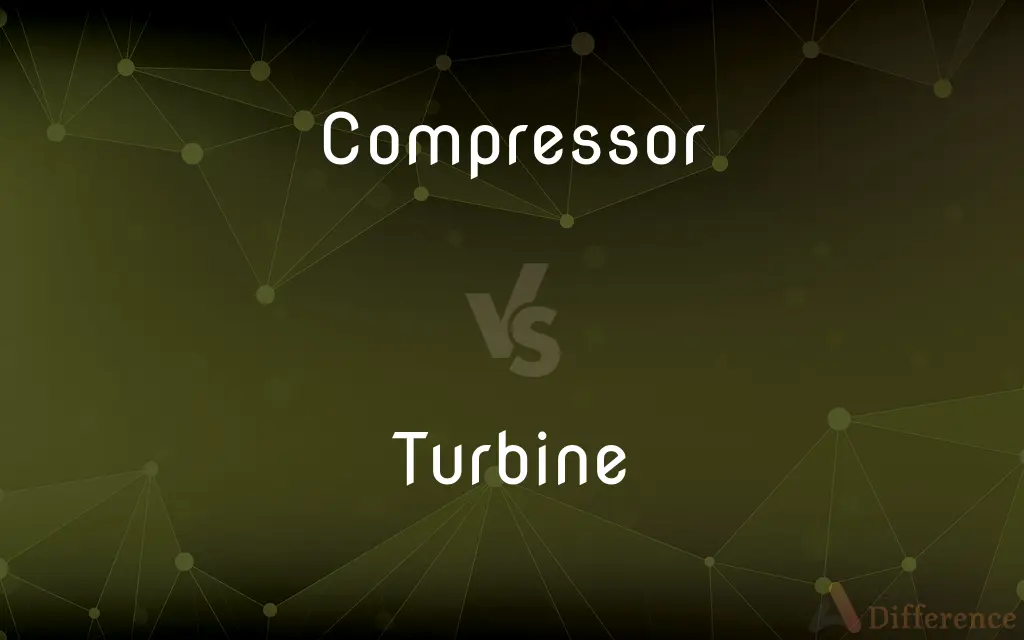Compressor vs. Turbine — What's the Difference?
By Tayyaba Rehman — Updated on October 31, 2023
A compressor increases the pressure of a gas by reducing its volume, while a turbine converts fluid or gas energy into mechanical work.

Difference Between Compressor and Turbine
Table of Contents
ADVERTISEMENT
Key Differences
Compressors function to increase the pressure and decrease the volume of gases, while turbines extract energy from moving fluids, including gases and liquids. A compressor requires energy input to compress the fluid, often used in refrigeration and air conditioning systems. In contrast, turbines generate energy output as the fluid expands and accelerates through the turbine blades.
A compressor typically intakes air or gas at atmospheric pressure, compressing it to a higher pressure. Turbines operate in reverse, starting with high-pressure fluids that transfer energy to the turbine as they move to lower pressure. Compressors are the starting point for gas-powered energy generation, while turbines are often the endpoint where energy is harvested.
Energy flow in compressors is upstream, meaning energy is put into the system, compressing the gas, which is subsequently stored or used for mechanical work. Turbines, conversely, facilitate downstream energy flow, where the potential energy of a fluid or gas is converted into mechanical energy as it passes through the turbine's blades, often to drive generators for electricity.
While compressors are essential components in jet engines, providing compressed air to mix with fuel for combustion, turbines in the same engines extract energy from the hot exhaust gases to power the compressor and produce thrust. The interplay of compressors and turbines is crucial for the efficiency of various power generation systems, including thermal power plants.
Safety measures for compressors include ensuring they are properly sealed to handle high pressures, whereas for turbines, the focus is on maintaining blade integrity and ensuring they can withstand the mechanical stresses of high-speed rotation. Maintenance for compressors often involves checking for leaks and wear on compression seals, while for turbines, blade wear and alignment are critical.
ADVERTISEMENT
Comparison Chart
Function
Increases gas pressure by reducing volume
Converts fluid energy to mechanical work
Energy Flow
Energy input required to compress fluids
Energy output as fluids expand and move
Operating Principle
Air or gas is compressed
Fluid or gas expands through blades
Role in Engines
Provides compressed air for combustion
Extracts energy from exhaust for thrust
Maintenance Focus
Seals, leaks, and pressure containment
Blade integrity and alignment
Compare with Definitions
Compressor
A device that compresses air for pneumatic tools.
He used a compressor to inflate the tires quickly.
Turbine
A rotary mechanical device that extracts energy from fluid flow.
The hydroelectric dam uses a turbine to generate electricity.
Compressor
A machine that increases the pressure of a gas.
The industrial compressor efficiently pressurized the natural gas for storage.
Turbine
A device converting kinetic energy of fluids to mechanical work.
Wind turbines along the coast harness the power of sea breezes.
Compressor
An essential component in refrigeration cycles.
The fridge stopped cooling when its compressor broke down.
Turbine
Equipment in power plants that drive electric generators.
Steam turbines have been central to thermal power generation for over a century.
Compressor
Equipment that reduces the volume of gas to increase pressure.
The new air conditioning system has a more powerful compressor for better efficiency.
Turbine
A rotating part of a jet engine that extracts energy from high-temperature gases.
The jet's turbine blades can withstand extreme temperatures.
Compressor
A mechanical device for gas compression in various industries.
The plant's compressor was audible from a distance due to its size.
Turbine
A machine with blades that rotate due to fluid force.
The company plans to install a turbine at the river bend for clean energy.
Compressor
A compressor is a mechanical device that increases the pressure of a gas by reducing its volume. An air compressor is a specific type of gas compressor.
Turbine
A turbine ( or ) (from the Greek τύρβη, tyrbē, or Latin turbo, meaning vortex) is a rotary mechanical device that extracts energy from a fluid flow and converts it into useful work. The work produced by a turbine can be used for generating electrical power when combined with a generator.
Compressor
A pump or other machine that increases the pressure of a gas.
Turbine
A machine for producing continuous power in which a wheel or rotor, typically fitted with vanes, is made to revolve by a fast-moving flow of water, steam, gas, air, or other fluid.
Compressor
An instrument or device that compresses, such as a forceps or clamp.
Turbine
Any of various machines in which the kinetic energy of a moving fluid is converted to mechanical power by the impulse or reaction of the fluid with a series of buckets, paddles, or blades arrayed about the circumference of a wheel or cylinder.
Compressor
A muscle that causes compression of a body part.
Turbine
Any of various rotary machines that use the kinetic energy of a continuous stream of fluid (a liquid or a gas) to turn a shaft.
Compressor
A device that produces pressure, such as a gas compressor that produces pressurized gas.
Turbine
A water wheel, commonly horizontal, variously constructed, but usually having a series of curved floats or buckets, against which the water acts by its impulse or reaction in flowing either outward from a central chamber, inward from an external casing, or from above downward, etc.; - also called turbine wheel.
Compressor
A device that squeezes (compresses).
Turbine
A type of rotary engine with a set of rotating vanes, diagonally inclined and often curved, attached to a central spindle, and obtaining its motive force from the passage of a fluid, as water, steam, combusted gases, or air, over the vanes. Water turbines are frequently used for generating power at hydroelectric power stations, and steam turbines are used for generating power from coal- or oil-fired electric power stations. Turbines are also found in jet engines, and in some automobile engines.
Compressor
An instrument for compressing an artery (especially the femoral artery) or other part.
Turbine
Rotary engine in which the kinetic energy of a moving fluid is converted into mechanical energy by causing a bladed rotor to rotate
Compressor
An apparatus for confining or flattening between glass plates an object to be examined with the microscope; a compressorium.
Compressor
A machine for compressing gases, especially an air compressor.
Compressor
(audio) A device that reduces the dynamic range of an audio signal.
Compressor
(anatomy) A muscle that compresses certain parts.
Compressor
(computing) A program or algorithm for compressing data.
Compressor
Anything which serves to compress
Compressor
A mechanical device that compresses gasses
Common Curiosities
Are compressors used in refrigeration?
Yes, compressors are key components in refrigeration systems.
Do turbines generate electricity?
Turbines commonly drive generators to produce electricity.
How does a turbine work?
A turbine converts the energy of fluids or gases into mechanical work.
What types of turbines are there?
There are wind, steam, gas, and water turbines, among others.
What is the main safety concern with compressors?
The main concern is ensuring they can handle high pressures safely.
Can compressors be used to power tools?
Yes, compressors often provide air for pneumatic tools.
What fluids can a turbine use?
Turbines can use steam, water, gas, or air.
What does a compressor do?
A compressor increases the pressure of gases or air.
Are compressors energy efficient?
Modern compressors are designed to be energy-efficient, though it varies by type and application.
Do turbines have to move quickly?
Yes, most turbines require high-speed rotation to be effective.
What is a common use of turbines in transportation?
Turbines are used in jet engines for aircraft propulsion.
How do compressors affect air quality?
Compressors can introduce oil or contaminants if not properly maintained.
What determines the size of a compressor?
The required pressure and volume of air or gas determine the compressor's size.
How often do compressors need maintenance?
Maintenance frequency depends on usage, but regular checks are essential for safety and efficiency.
Can turbines work with any fluid?
Turbines need a fluid with enough force to turn the blades, like steam, water, or gas.
Share Your Discovery

Previous Comparison
Freeway vs. Parkway
Next Comparison
Agenda vs. NoticeAuthor Spotlight
Written by
Tayyaba RehmanTayyaba Rehman is a distinguished writer, currently serving as a primary contributor to askdifference.com. As a researcher in semantics and etymology, Tayyaba's passion for the complexity of languages and their distinctions has found a perfect home on the platform. Tayyaba delves into the intricacies of language, distinguishing between commonly confused words and phrases, thereby providing clarity for readers worldwide.
















































